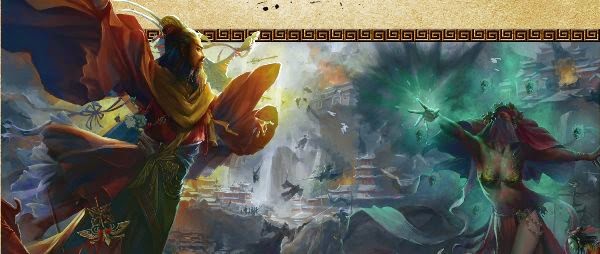
As you can guess by the name of the title, the aim of the game is to slay demons, seven of them in fact, but before you can do so you’ll need to fight through their cadre of acolytes, the dreaded heart eaters. This is achieved by building your deck around immortals, powerful celestial beings on the side of light. For every heart eater and demon you slay you are awarded cultivation and the winner is the player with the most cultivation after every demon has been slain.
As is customary in deck builders there is a common pool of cards from which players can purchase throughout the game, called the Infinite Isles. These can give players extra clarity, the main currency for buying cards, attack bonuses and allow card manipulation; discards, draw extra cards or cycle through your deck. Each player also has access to three unique immortals; these three cards are based around a single elemental theme and are the most powerful in the game.
Even though there are mechanical differences Demonslayer feels very much like Thunderstone. There are a couple of unique twists, however, in the form of artefacts and miasma. At any point players can attempt to create artefacts, permanent cards that grant bonuses throughout the game. You can either pay for them out of your cultivation pool or attempt a roll of the dice to get one for a reduced cost. It’s a great concept and some of them are extremely useful but there isn’t a huge variety in the artefacts available. The miasma also feels like a slightly underused effect. Certain heart eaters, when defeated, will infect you with a miasma card, and when the card comes back around into your hand it causes a negative effect. You can skip your turn to discard the miasma but if multiple miasma cards appear in your hand at once you’re properly stuffed. The problem is that not many of the heart eaters cause miasma infections and there are various cards that can cancel their effect or quickly discard them. It means that they hardly come out and getting even three in your deck at a time is a rare occurrence.
Where Demonslayer absolutely nails it is the application of theme and the art. With deck builders you’re always going to have a bit of abstraction but here the cards types tie together nicely, immortals, spells, followers and meditation come together to go to Mount Kunlun and kick demon arse. And everyone there is handsomely turned out; all of the artwork evokes the high fantasy aspect of the setting while keeping with a distinctly eastern style.
Altogether it’s just enough to make the game stand apart from the competition. The four different immortal sets mean that each player is going to have a particular strategy that their immortals or more biased to. Also because acolytes can be attacked in any order it give the opportunity for some strategic attacking, holding back to avoid a particularly nasty heart eater or attempting to force your opponents towards lower scoring enemies. Ultimately you want to be the person taking down the final demon in the wave as this is where the greatest reward lies and in larger player games this can take some careful timing.
The area where Demonslayer is lacking at this time is variety. In almost every single other deck builder on the market you will have a variety of cards to purchase that change every game. Unfortunately in Demonslayer what you see is what you get. The Infinite Isles pool of cards is the same in every game and you’ll see every single heart eater and Demonslayer in each game. At the time of reviewing I don’t know the retail price of Demonslayer so I don’t know how it compares to other games for value for money but it does mean the game does have limited re-playability. Having four different immortal sets to play with does increase the variation and to be fair means you’re going to get at least four games out of Demonslayer before you’ve seen everything.
So does Demonslayer do anything new? In short no, almost every mechanic you’ve seen before, but it does blend these elements very well and it doesn’t do anything wrong. The four different flavours of immortals give you a variety of strategies that change the way you play. Having choices on whom to attack gives rise to plenty of tactical options and the artefacts and miasma, although implemented a little sparingly give ample opportunities to further extend your strategy. The game needs more variety in the Infinite Isles to guarantee its longevity but there’s plenty here to enjoy in this great, if a little familiar, deck builder.















.png)


0 comments:
Post a Comment